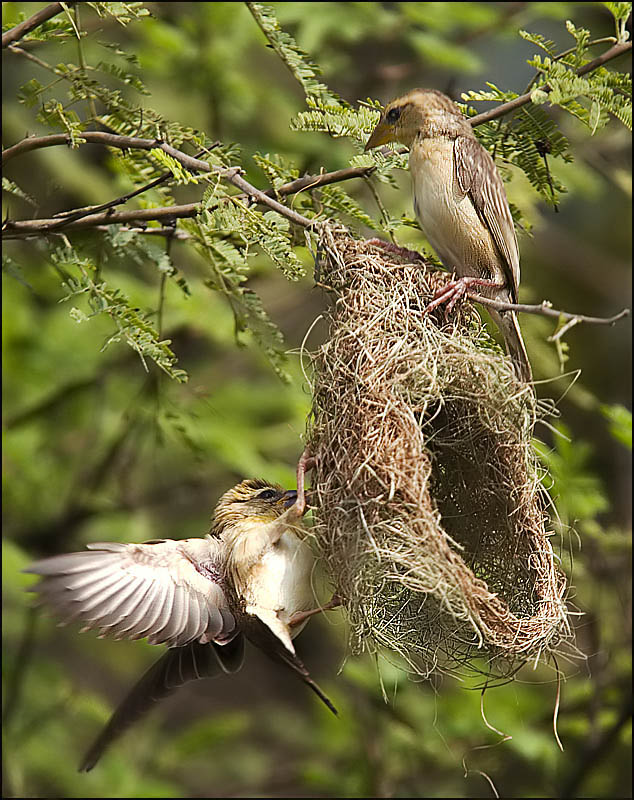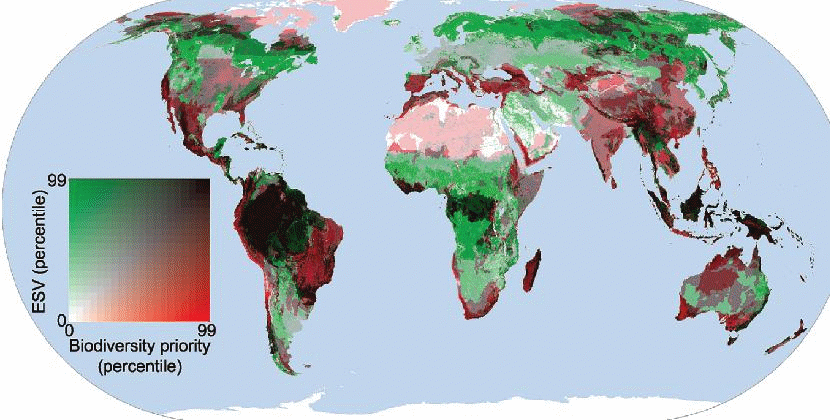| Biodiversity Conservation and Ecosystem Services As human populations grow, so do the resource demand imposed on ecosystems and the impacts of our global footprint. Many people have been plagued with the misconception that these ecosystem services are free, invulnerable and infinitely available. However, the impacts of anthropogenic use and abuse are becoming evermore apparent – air and water quality are increasingly compromised, oceans are being over-fished, pests and diseases are extending beyond their historical boundaries, deforestation is causing floods, landslides displacing human settlements. The Millennium Ecosystem Assessment (MA, 2005) was the first comprehensive global assessment of the implications of ecosystem change for people and it came about as the result of a call in 2000, by the then UN Secretary-General Kofi Annan, to "assess the consequences of ecosystem change for human well-being and the scientific basis for action needed to enhance the conservation and sustainable use of those systems and their contribution to human well-being" The key finding was that currently 60% of the ecosystem services evaluated are being degraded or used unsustainably and such a situation has major implications for development, poverty alleviation, and the strategies needed by societies to cope with - and adapt to - long-term environmental changes. Brundtland Report argued that it is one of the major factors leading to environmental degradation and loss of biodiversity. The government strategies and policies should consider the impacts not only upon ecosystems but also the social and economic systems. Choices we make should be based on a good understanding of biophysical limits that constrain ecological processes and the scales at which they operate. Biodiversity, ecosystem function and services Healthy ecosystems that provide people with essential natural goods and services often overlap with regions rich in biological diversity, underscoring that conserving one also protects the other. Global Conservation of Biodiversity and Ecosystem Services report confirms the value of making biological diversity a priority for conservation efforts. It shows that more than 70 percent of the world’s highest priority areas for biodiversity conservation also contain significant value in ecosystem services such as fresh water, food, carbon storage, storm buffers and other natural resources that sustain human life and support social and economic development. According to a study by scientists from Conservation International, the Gund Institute for Ecological Economics at the University of Vermont, and the Global Environment Facility, the value of ecosystem services in the 7 percent of the planet of greatest biodiversity conservation priority was more than double the global average. Overall, the annual value of the world’s ecosystem services is estimated at $33 trillion, far greater than the gross national product of all nations combined. This clearly shows that in many places in the world, strategies targeted at conserving threatened biodiversity also help protect ecosystems, thereby improving human well-being and alleviating poverty. It identifies tropical forests as places of particularly high overlap of priorities because of their biological diversity and ecosystem services essential to the welfare of many of the world’s 1 billion people living in extreme poverty. With climate change recognized as the greatest environmental threat facing the planet, the study provides a timely reminder that investments to maintain healthy ecosystems and their restorative powers is cost effective for biodiversity, the livelihoods of local people and economic development, and as a way to protect the CO2 stored in these areas from release. Restoring destroyed forests also is necessary to help damaged habitat recover, ensure the persistence of species, and restore critical ecosystem services, particularly in regions with large human populations. Environmental contamination and biodiversity We are altering the composition of biological communities through a variety of activities that increase rates of species invasions and species extinctions, at all scales, from local to global. They have a strong potential to alter ecosystem properties and the goods and services they provide to humanity. Ecological experiments, observations, and theoretical developments show that ecosystem properties depend greatly on biodiversity in terms of the functional characteristics of organisms present in the ecosystem and the distribution and abundance of those organisms over space and time. Decline of the insectivorous birds and birds of prey has been commonly reported and experienced in many parts of India. Populations of even the drongos, bee-eaters and Baya have plummeted drastically in recent years. In some places, the beautiful tubular nests of Baya have become totally absent. Often, the blame goes to the tons of pesticides and fertilizers used in the agriculture crops. The case of bees It has been estimated that the production of over 75% of the world’s most important crops and 35% of the food produced is dependent upon animal pollination (Klein et al., 2007). Bees are the dominant taxa providing crop pollination services, but birds, bats, moths, flies and other insects can also be important. Pollinator diversity is essential for sustaining this service. The loss of biodiversity in agro-ecosystems through agricultural intensification and habitat decline has adversely affected pollination systems and has caused the loss of pollinators throughout the world . The consequences of such losses of pollinators for ecosystem functioning have been documented and there are a number of cases where low fruit or the setting of seeds by crops and the reduction in crop yields has been attributed to a fall in pollinator diversity. There is increasing evidence that conserving wild pollinators in habitats adjacent to agriculture improves both the level and stability of pollination, leading to increased yields and income. Indeed, several studies have demonstrated that the loss of natural and semi-natural habitat can impact upon agricultural crop production through reduced pollination services provided by native insects such as bees. Thus while species richness per se may be important in relation to the maintenance of ecosystem functioning, the role of particular ‘keystone’ species or groups, with particular functional capabilities in communities cannot be overlooked. What can we do to reduce biodiversity loss as individuals/ school/ community? Each of us has a role to play in ensuring the future health and well-being of all the people, animals, plants and ecosystems on the planet. Responsible choices can help us all save energy, protect habitats and support a more sustainable future for communities all over the world. 1. Minimising Carbon footprint: Fossil fuel extraction and carbon emissions impact species, the places they live, and the people who depend on them around the world. By reducing the energy and fossil fuels we use, we are saving the environment from further damage. 2. Being a green consumer: It is clearly evident that the things we buy and use have an effect on the environment. Being aware of what the things we buy are made of, where they come from, and how they reach us. All of this knowledge determines how we impact biodiversity in our back yard and around the world. We have the power to choose. 3. Eating green: Clearing forest for agriculture is one of the leading causes of global deforestation and habitat destruction. Environmentally friendly eating habits are easy and healthy. 4. Exploring biodiversity: The diversity of nature is everywhere. So let us see what’s been living right outside our door. 5. Enhancing local biodiversity: Contributing to diversity in our neighborhood can go a long way toward feeling good every day - Planting and caring for native trees and shrubs, replacing chemical fertilizers and pesticides with natural products and creating and managing community green spaces. 6. "Doing it the nature’s way" Nature keeps it simple and offers basic solutions to all problems. We can change the way we grow food, make materials, harness energy, heal ourselves, store information and conduct business. Nature tells us: How to live in this planet without destroying it • How to grow our food • How to make our materials • How to power ourselves, heal ourselves and store what we learn and • How to conduct business in an eco-friendly way Discover biodiversity - every day To increase awareness of the enormous variety of life on our planet, and raise the profile of threatened species, IUCN Red List ‘Species of the Day’ has been launched as a part of the International year of biodiversity. Each day of 2010 will see a different species featured on the IUCN website, with information on the threats it faces. The 365 species selected represent the entire range of taxonomic groups and cover all regions. Click on www.cleanindia.in to view the species of the day. q Usha Srinivasan Reference: Roy haines-young marion potschin. Centre for environmental management, school of geography, university of nottingham |

